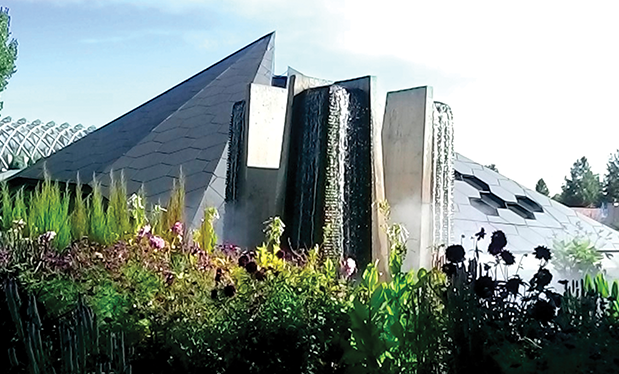Since it was first quarried in the U.S. during the 19th century, natural slate has been a defining feature of historical residential and commercial architecture. Slate still is considered an exceptionally beautiful, reliable and practical roofing material—but it must be installed properly. Having withstood the test of time, there is a reason why the demand for slate has consistently been high.
However, the material is not ideal for all installations. If you are less experienced or less familiar with the installation intricacies of natural slate, it's helpful to become familiar with five common mistakes made while installing slate roof systems.
Considering field feedback from roof system installers, as well as reputable sources such as The Slate Roof Bible by Joseph Jenkins, the following are the five most common mistakes made while installing slate roofing.
No. 1
The first common mistake is not having adequate knowledge about slate roofing options. There are several roofing material options available. Among varieties of natural slate, asphalt and engineered materials such as Ply Gem Industries Inc.'s engineered slate, choices are abundant. However, before you commit to a certain material, don't make assumptions about a product's capabilities or resilience. I recommend educating yourself by consulting knowledgeable slate installers and/or consultants who may have worked with a particular product for many years because they will best be able to answer your specific questions about installing the product.
I also encourage a fair amount of Internet research. However, as always, only conduct research on reputable websites, such as theslateroofexperts.com, slateroofers.org or www.nps.gov. A search can provide invaluable sources of information and videos about materials, tools and installation techniques.
Consider the price, color, thickness, type and manufacturing quality when you are conducting research. Less expensive imported slates, such as slates from China, may be more brittle than slate quarried in the U.S.
Size also matters when it comes to choosing between seemingly different qualities of slate. The smaller the slate shingle, the more shingles are required to cover each square foot on a roof. Because each shingle is attached to a roof deck with two nails, installing smaller slate shingles will involve more labor.
No. 2
The second common mistake is using poor quality slate. Among the many slate roofing options, you will find a wide range of high- and low-quality slates. It is important to know the source of the slate, the supplier and its reputation. Most U.S. and Canadian slates are dependable products. However, there are many foreign slate materials being presented as viable options with minimal background about their performances over time. Some roofing slates, though from reliable regions, may contain pyrites that will run red stains down a roof.
To ensure the slate you choose will properly serve building owners and homeowners, there are a few important factors to consider:
- Fire rating: Slate materials have different burning speeds and, therefore, undergo independent third-party testing or ASTM's E-84 fire testing for class A, B or C rating.
- Wind testing: Especially if you are building in a storm-prone area, you'll want to make sure the slate material has completed rigorous wind-uplift testing. I recommend looking for UL 1897, "Uplift Tests for Roof Covering Systems," the Florida Building Codes' Testing Application Standard (TAS) No. 100, "Test Procedure for Wind and Wind Driven Rain Resistance of Discontinuous Roof Systems" and TAS No. 107, "Test Procedure for Wind Resistance Testing of Non-Rigid, Discontinuous Roof System Assemblies" certifications.
- Impact resistance: In hail-prone areas, you'll want to make sure the slate you use has passed UL 2218, "Standard for Impact Resistance of Prepared Roof Covering Materials" hail rating.
- Freeze-thaw resistance: Temperature changes can cause shingles and shakes to buckle and crack, resulting in an uneven roof. Make sure the slate material you choose to use has undergone freeze-thaw testing according to ASTM D1037, "Test Methods for Evaluating Properties of Wood-Base Fiber and Particle Panel Materials."
If a manufacturer is confident in its product, it likely will offer a long-standing warranty. Confidence in a product comes from the completion of multiple tests and certifications.
No. 3
The third common mistake is installing slate on an insufficient support structure. The slate you choose may claim to last more than a lifetime, but what if the roof structure or building collapses under the weight? One of my strongest recommendations is always be sure the substructure requirements are met to support the type and style of slate roof on which you are working. This is assuming you will have avoided mistake No. 1 with adequate research regarding slate substructure requirements of the product you are using.
Real slate products can weigh more than 1,000 pounds per square foot. For easier installation, consider newer alternatives such as engineered slate, which only weighs 375 pounds per square foot. At a weight almost three times lighter, engineered slate is as durable as natural slate.
If you are unfamiliar with installing an engineered product, know engineered roofing materials are installed with the same standard roof calculations as asphalt shingles. In fact, engineered slate needs no reinforcements or additional structural evaluations.
No. 4
The fourth common mistake is not collating the slate properly. An unsightly installation not only is aesthetically displeasing, but it also can be expensive and may need to be torn down and reinstalled. To prevent a disastrous installation, consider the following:
- Slate should be collated from every pallet after all the slate is on the job site. Even if the slate you select to work with is all from the same source, different pallets can contain different shades. All the pallets delivered should be opened and shuffled on-site. Avoid beginning with one pallet, installing the slates and then opening another pallet.
- Roofing workers must pay attention to blending the material during collation and installation. From the starter course until the end of a job, contractors must assess the aesthetics and positioning of every slate roofing job.
- Confirm the blend of the slate from all the pallets at regular intervals during installation. Communication between contractor and crew is key, and frequent evaluations should be made throughout each slate roofing job regarding pallet shade.
If you want to reduce the need for job-site color placement, consider options such as engineered slate, which comes in standard and custom-color families that are pre-blended in the bundle. Pre-blended slates mean less time spent on blending and less room for error on a job. To develop the most natural looking colors, some slate companies will visit locations throughout the northeastern U.S. to find the most prominent, sought-after colors that complement historic architecture.
No. 5
The fifth common mistake made during slate roof system installations is walking on the slate during installation. Walking on installed slate can break it and create damage that cannot immediately be seen, and the wear will reveal itself over time. For example, I've seen many hairline cracks and breaks at the nail holes on slate roofs that have been walked on during installation.
You usually can tell whether a slate material easily will damage by its impact-resistance classification. A Class 4 impact rating is the highest possible rating. Workers can walk on an engineered slate roof without damaging it, saving installation time and reducing waste.
If working with a slate material with a lower impact resistance, consider investing in roof jacks or roof brackets that create roof scaffolds to allow workers to safely work on slate roofs.
Know your slate
I've identified five of the most common mistakes when installing slate roofing, but it's necessary to reiterate the importance of being educated about a product before embarking on a slate roof system installation project. Historically, natural slate is a beautiful and high-performing roofing material for many applications. By avoiding common mistakes, you can be more confident the slate roof systems your company installs will have long, durable lifespans.
Dave Derogatis is director of composites for Ply Gem Industries Inc., Cary, N.C.
For an article related to this topic, see "New slate standards," May 2004 issue.



